Linear Equations in Discrete mathematicsAn equation will be known as a linear equation if it contains the highest power of variable 1. The linear equation is also known as the one-degree equation. There is a way in which we can indicate the linear equation in one variable, i.e., Ax+B = 0. Here, A is used to indicate the coefficient, x is used to indicate the variable, and B is used to indicate the constant. There is one more way in which a linear equation that has two variables can be indicated, i.e., Ax + By = C. Here, A, and B are used to indicate the coefficient, x and y are used to indicate the variables, and C is used to indicate the constants. What is Linear Equation?A linear equation can be described as an equation that contains the highest degree of 1. That means a linear equation cannot have that type of variable whose exponent is more than 1. If we draw a graph with the help of a linear equation, then it will always form a straight line. For example: Suppose there is a linear equation y = 2x+1. Now we will draw a graph for this equation like this: 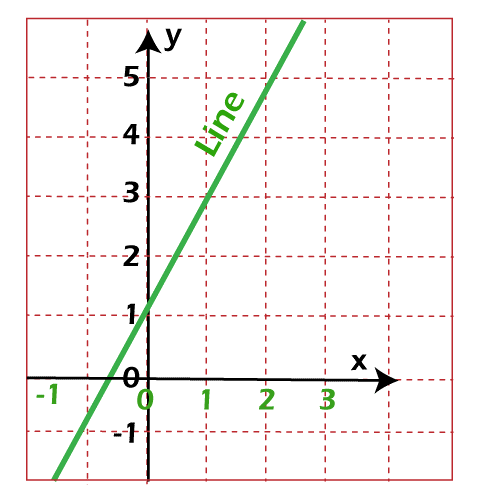
As we can see that the graph of equation y = 2x+1 is a straight line. There are some points in this graph which are described as follows:
Some examples values of this graph are described as follows: X y = 2x+1 -1 y = 2*(-1) + 1 = -1 0 y = 2*0 + 1 = 1 1 y = 2*1 + 1 = 3 2 y = 2*2 + 1 = 5 We can check that all these points are part of the above shown straight line. Definition of Linear EquationAn equation can also be known as a mathematical statement that has the ability to contain an equal sign (=) between the algebraic expression. These types of an equation must contain degree 1. It always forms a straight line when we plot it on a graph. Because of this reason, this type of equation can be called the "linear equation". There are three ways to represent the linear equation, i.e., linear equation in one variable, linear equation in two variables, and linear equation in three variables. In the process of solution of linear equations, the values will be generated, which makes the given equation true when we substitute these values for the unknown values. For example: Suppose we have an equation x+2 = 0. This equation can only provide one solution, i.e., x = -2. But if there is a linear equation in two variables, then for this, the solutions are calculated in the form of Cartesian coordinates of a point of the Euclidean plane. Now we will show some equations and identify which are a linear equation and a non-linear equation.
Formula of Linear EquationWith the help of formula of linear equation, we can express a linear equation. There are many ways in which we can do this. For example: We can express the linear equation in various ways, such as in slope intercept form, standard form, or the point-slope form. Now we will learn about the way in which a linear equation can be expressed with the help of learning the standard form of the linear equation. On the basis of the number of variables in the equation, the formula of a linear equation is dependent. We should also keep in mind that the highest degree of all variables in the equation must be one. Form of a Linear EquationThere are various forms in which we can show a linear equation, which is described as follows:
Now we will learn them one by one in detail like this: 1. Standard form of Linear equations There are three ways in which we can write linear equations, i.e., one variable form and two variable forms, and three variable forms. The one variable form is also known as the standard form. The standard or general form of the linear equation can be written in the following way for one variable: Here A and B are used to indicate the real numbers, and x is used to indicate the variable. The standard form of a linear equation can be written in the following way for two variables: Here, x and y are used to indicate the variables, and A, B, and C are used to indicate the real numbers or constants. 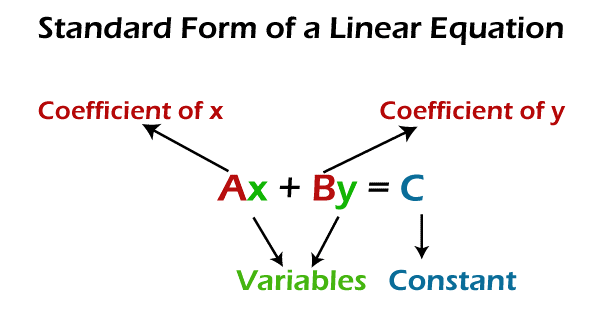
The standard form of a linear equation can be written in the following way for three variables: Here, x, y, and z are used to indicate the variables, and A, B, C, and D are used to indicate the real numbers in such a way that A ≠ 0, B ≠ 0, and C ≠ ;0. 2. Slope Intercept Form The slope intercept form is a type of most common form to indicate a linear equation, which is described as follows: y= mx+b Here, m is used to indicate the slope of a line x and y are used to indicate the coordinates of x-axis and y-axis, respectively. b is used to indicate the y-intercept. The slope-intercept equation of a straight line is described in the following graph: 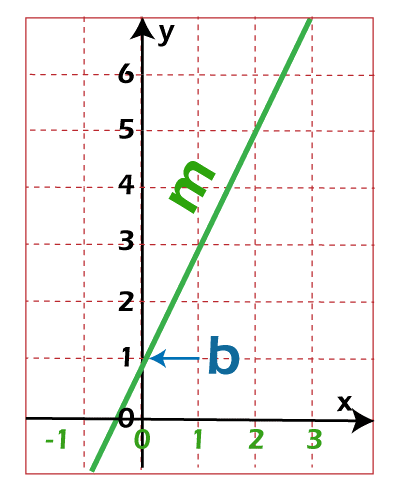
For example: y = 3x + 7 Slope, m = 3, and intercept b = 7. If there is a straight line that is parallel to the x-axis, in this case, the x coordinates will be zero. Therefore, If there is a line that is parallel to the y-axis, in this case, the y coordinates will be zero. Slope: We can determine the slope of a line with the help of calculating the ratio of change in y coordinates to the change in x coordinates. The m is used to indicate the slope. The following formula is used to calculate the slope: So basically, the slope is used to indicate the rise of line in the plane as well as the distance covered on the x-axis. We can also call the slope of a line as a gradient. 3. Point Slope form If we consider the points in the x-y plane, then we can form a straight line equation in the form of a linear equation, which is described as follows: Where (x1, y1) are used to indicate the coordinates of the point. There is one more way to express this, which is described as follows: The point-slope equation of a straight line is described in the following graph: 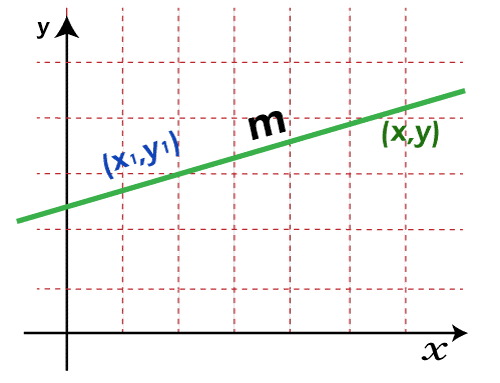
4. As a function: a) Sometimes, we can write the linear equation in the form of a function with the help of f(x) instead of y. For example: y = 5x - 9 f(x) = 5x - 9 Both the above equations are the same. b) We cannot always write a function with the help of f(x). For example: y = 5x - 9 w(u) = 5u - 9 h(z) = 5z - 9 All the above three equations are also the same. 5. Identity Function A linear equation contains a special type of function, which is known as the identity function. The following syntax is used to indicate the identity function, which is described as follows: f(x) = x The graph of identity function is described as follows: 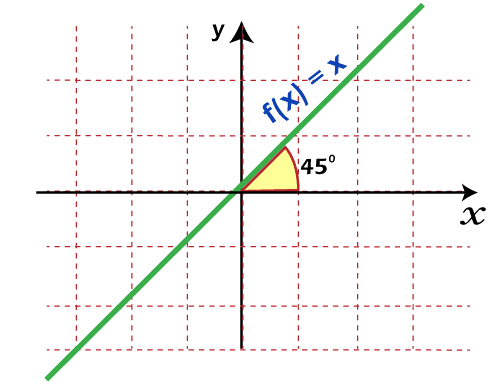
The above graph creates a 45°, and its slope is 1. In the case of identity function, the in-value and out-value will always be the same. That means the value we enter as an input gets the same value as output. That's why it is known as identity.
6. Constant Function
There is one more special type of linear function, which is known as the constant function. This function always draws a horizontal line. The following syntax is used to indicate the constant function, which is described as follows: f(x) = C The graphical representation of a constant function is described as follows: 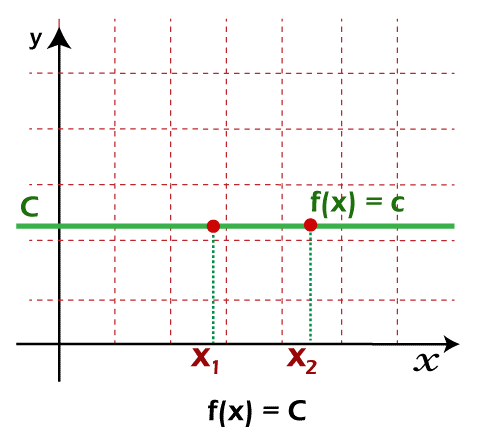
In the constant function, the f(x) will always equal to the constant value. In this case, the value of x will not matter. It is also equal to a constant value. Summary: A linear equation can be written in a lot of different forms, and some of them are described as follows:
Where m is used to indicate the slope of a line and (a, b) is used to intercept the x-axis and y-axis. Graph of a Linear EquationIf there is a linear equation that has one variable, then it will form a vertical line in a graph, and that type of line will be parallel to the y-axis and vice versa, whereas if there is a linear equation that has two variables, then it will form a straight line in a graph. Now we will draw a graph for a linear equation that has two variables by some examples, which are described as follows: Example: Here, we will have a linear equation in two variables x - 2y = 2. We will draw a graph for this equation. We will use some steps to plot the linear equation in a graph, which is described as follows: Step 1: In this step, we have a linear equation x - 2y = 2. Step 2: Now, we will use the form y = mx+b and convert the given equation into this form. After converting, we will get y = x/2 -1 Step 3: In this step, we will replace the x's value for different numbers, and the result of these replacements will get in the form of y to create the coordinates. Step 4: In this step, we will put x = 0 in the above equation y = x/2 -1. After this, we will get y = 0/2 -1, i.e., y = -1. In the same way, if we put the x's value as 2 in the same equation, then we will get y = 2/2 -1, i.e., y = 0. Step 5: In this step, we will put x's value as 4 in equation y = x/2 -1. After putting this, we will get y = 4/2 -1, i.e., y = 1. Similarly, if we put the x's value as -2 in the same equation, then we will get y = -2/2 -1, i.e., y = -2. Now the linear equation y = x/2 -1 will be satisfied by these pairs of values (x, y). In the following table, we can show the list of all the coordinates.
Step 6: In the last step, we will plot all the above points (4, 1), (2, 0), (0, -1), and (-2, -2) on the graph, and when we join them, we will get a straight line. With the help of above steps, we can show a linear equation on a graph. 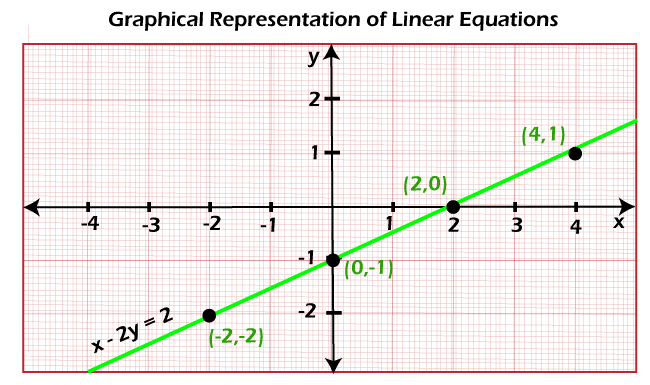
Linear Equation in One variableA linear equation in one variable can be described as an equation that contains only a single variable. These types of equations must be in the form Ax + B = C. Here, x is used to indicate an unknown variable that contains only one solution, and A, B are used to indicate the real numbers. With the help of this way, we can easily show a mathematical statement. The linear equation always contains a degree that must be equal to 1. An equation always has two sides, and both sides must be balanced so that we can solve a linear equation. The equality sign of the equation is used to show that both sides of the expression are equal. It is very easy to solve a linear equation that contains only one variable. We can get the unknown variable's value with the help of separating the variable and constants. We will keep the variable on one side of the equation, and constants are combined and put on the other side of the equation. After that, we will perform some operations on both sides in such a way that the balance of the equation will not be affected. Example 1: Here, we have to solve a linear equation that has one variable, i.e., 2x + 5 = 23. Solution: We can solve this equation if we keep the variable on the LHS and numbers on the RHS. This means we will do the equation in the following way such as 2x = 23-5. Now, we will solve the value of x and get 2x = 12. Finally, we will get x's value as x = 12 /2 = 6. Example 2: Here, we have to solve a linear equation that has one variable, i.e., (2x-10) /2 = 3(x-1). Solution: We will solve this with the help of some steps, which are described as follows: Step 1: First, we will clear the fraction like this: (2x-10) / 2 = 3(x-1) x - 5 = 3(x-1) Step 2: Now, we will simplify both sides of the equation like this: x - 5 = 3x-3 x = 3x+2 Step 3: Now, we will isolate x like this: x - 3x = 2 -2x = 2 x = -1 Linear Equation in Two VariablesA linear equation in two variables can be described as an equation that contains two variables. These types of equations must be in the form Ax + By + C = 0. Here, x and y are used to indicate two variables, and each variable has degree 1, and A, B and C are used to indicate the real numbers. The value of A, B and C must not be equal to zero. If there are two such linear equations, then that equation will be known as the simultaneous linear equation. For example: 5x + 3y + 17 = 0 There can be infinite numbers of solutions for a single equation. If we want to find the value of two variables, then we have to choose a set of 2 equations like Ax + By + C = 0 and Dx + Ey + F = 0. Here, A, B, C, D, E, and F are used to indicate the constants, and A, B, D, and E must not be equal to zero. For example: Here, we have to solve the equations x+5y = 7 and x = y. Solution: From the question, we have two equations, x+5y = 7 ?? (1) x = y ??? (2) Now we will put the value of equation 2 into equation 1 and get the following: ? y+5y = 7 ? 6y = 7 ? y = 7/6 ? x = y = 7/6 Linear Equation in Three variablesIf we want to find the value of three unknowns, then we have to choose a set of 3 equations. We can solve the linear equation with 3 variables with the help of using one of the most popular methods, i.e., matrix method. A1x + B1y + C1z + D1 = 0 A2x + B2y + C2z + D2 = 0 and A3x + B3y + C3z + D3 = 0 Here A1, A2, A3, B1, B2, B3, C1, C2, C3, D1, D2, and D3 are used to indicate the real numbers, where A1, A2, A3, B1, B2, B3, C1, C2, C3 must not be equal to zero. Here, x, y, and z are used to indicate the variables. For example: Here, we have to solve the linear equations of three variables: x+3y-2z = 10 2x-y+6z = 3 x+y-2z = 5 Solution: From the above question, we have three equations. So we can use the following matrix to write these equations like this: AX = B 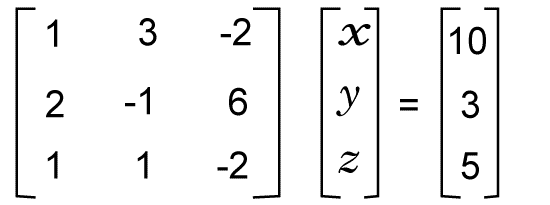
Now we have to find the inverse of this matrix so that we can determine the matrix X like this: X = A-1B Here we will do the determinant of matrix A like this: |A| = 1(2-6) -3(-4 - 6) -2(2+1) = -4 -3(-10) -2(3) = -4 + 30 - 6 = 20 Now we will determine the adjoint of matrix A like this: 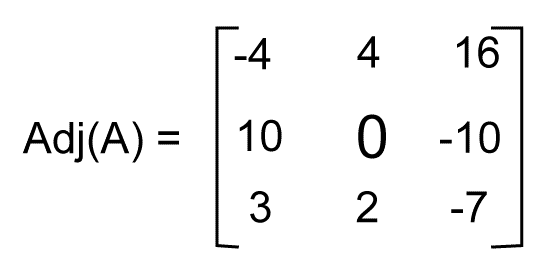
Now A-1 = (adj A) /|A| A-1 = 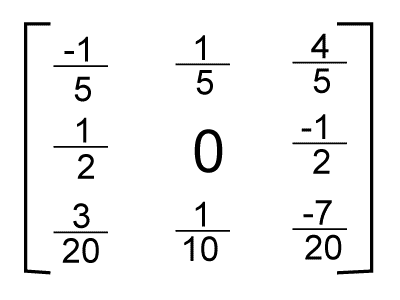
X = A-1B 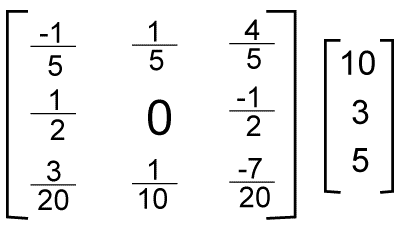
=> 
Thus the solution of above equation is described as follows: X = 60 /23 Y = 57 /23 Z = 1 /23 How to solve Linear EquationsAn equation can be described as a weighted balance with the same amount of weight on both sides. The given equation will still be correct or will not be affected if we add or subtract the same number from the LHS and RHS of the equation. Similarly, the equation will be correct if we multiply or divide the same number from the LHS and RHS of the equation. To solve the linear equation, we put all constants on one side and variables on another side, and after that, we will try to determine the value of unknown variables. With the help of this process, we can solve a linear equation with one variable. Now, we will understand this concept with the help of an example, which is described as follows: Example: Here, we have to solve an equation 5x-3 = 7. Now we will apply some mathematical operations on both sides of the equations, i.e., LHS and RHS, in such a way that the balance of it will not be disturbed. We will reduce the LHS to 5x by adding 3 to the LHS and RHS of the equation. Due to this addition, the balance of the equation will not be disturbed. So the new LHS will be 5x - 3 + 3 = 5x and the new RHS will be 7 + 3 = 10. Now we will reduce the LHS to x by dividing both sides of the equation by 5. Thus, we have x = 2. With the help of this way, we can solve a linear equation in one variable. Important PointsThere are some points that are important when we are learning the linear equations, which are described as follows:
Examples of Linear Equations:There are various examples of linear equations, and some of them are described as follows: Example 1: In this example, we have a linear equation x = 16(x+5), and we have to solve it. Solution: From the question, we have an equation x = 16(x+5) x = 16x + 75 Now we will subtract 75 from both sides of the above equation like this: x - 75 = 16x+75-75 x - 75 = 16x 15x = -75 x = -75/15 x = -5 Hence the value of x = -5. Example 2: In this example, we have two equations, x-y = 12 and 2x+y = 22, and we have to solve them. Solution: From the question, we have two equations x - y = 12 ....... (1) 2x + y = 22 ....... (2) Now we will isolate equation (1) for x like this: x = y+12 ......... (3) Now we will put equation (3) into equation (2) like this: 2(y+12) + y = 22 3y+24 = 22 3y = -2 y = -2/3 Now we will put y's value into x = y+12 like this: x = y+12 x = -2/3 + 12 x = 34/3 Hence, the value of x = 34/3 and the value of y = -2/3 Example 3: In this example, we have a linear equation 5x - 95 = 75, and we have to solve it. Solution: From the question, we have an equation 5x-95 = 75. 5x = 75+95 5x = 170 x = 170/5 x = 34 Hence, the value of x is 34. Example 4: In this example, ten times more of a number is equal to 50. Here, we have to form a linear equation and determine the value of an unknown number. Solution: For this, we will assume that the unknown number is x. According to the question, we know that ten times of this number is equal to 50. This means 10x = 50. This equation is a linear equation that has one variable, and we can solve the value of this x, which is the unknown number. So, 10x = 50 x = 50/10 x = 5 Therefore, the unknown number = 5. Example 5: In this example, the sum of two numbers is 32. Here, we have to determine both numbers by framing a linear equation if one number is 8 times more than the other. Solution: Here, we will assume that the first number is x, so according to the question, the second number will be x+8. Now we can form a linear equation with the help of these values, which is described as follows: x + x+8= 32 2x+8 = 32 Now we will solve the above linear equation with the help of putting the variable on one side and constants on another side like this: 2x = 32-8 Now we will simplify the RHS and get the following: 2x = 24 x = 24 /2 x = 12 This means that our first number is 12. So, the second number will be 12 + 8 = 20 Therefore, our two numbers are 12 and 20. |
 For Videos Join Our Youtube Channel: Join Now
For Videos Join Our Youtube Channel: Join Now
Feedback
- Send your Feedback to [email protected]
Help Others, Please Share









